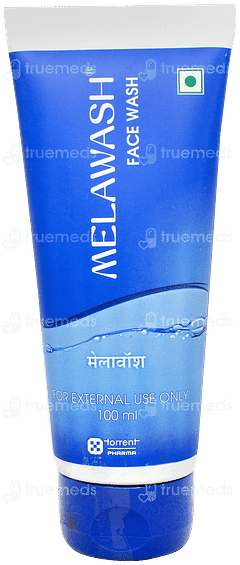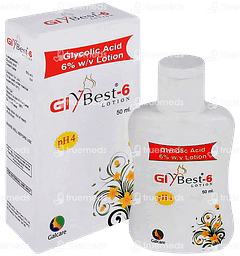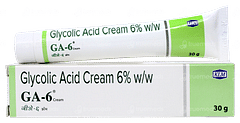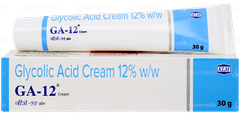Glycolic Acid
Uses of Glycolic Acid
- Glycolic Acid is used in skincare to improve skin texture and reduce signs of aging. It also helps treat acne, dark spots, acne scars, hyperpigmentation, aging skin, and rough patches like keratosis pilaris.
Side effects of Glycolic Acid
Mild stinging sensation
Redness
Skin dryness
Flaking of the skin
How Glycolic Acid works
Glycolic Acid is a type of alpha-hydroxy acid (AHA). It works by penetrating the skin and breaking down the substance that binds dead skin cells together. This causes the top layer of dead skin cells to shed, revealing the fresh, new cells underneath.
Certified content
Written By

BAMS, FMC, MD Resident
Reviewed By

Doctor of Medicine
Expert Advice
Dosage forms available
Glycolic Acid is available for applied via the topical route in the form of creams, lotions, serums, peels, and cleansers.
Age and dose restrictions
This medicine is meant for adults and children above 12 years of age.
Contraindications
Glycolic Acid is contraindicated in individuals with known hypersensitivity to it.
It should not be used by persons with recent facial waxing, laser treatments, active infections or open wounds on the skin.
Other medications to avoid
Glycolic Acid may interact with certain topical medications like antibiotics (such as clindamycin or erythromycin) and retinoids (such as tretinoin or adapalene).
Overdose and missed dose
Overdose of Glycolic Acid is unlikely as it is intended for external use only. Using the prescribed dosage is recommended to avoid any side effects.
If you forget to apply this medicine, apply it as soon as you remember. Avoid applying extra products to make up for a missed application.
Management of side effects
Most side effects are temporary and generally harmless and resolve when discontinuing this medicine. However, if you experience any severe side effects or worsening of any of the symptoms, please consult your doctor.
To minimise side effects such as dryness and flaking, apply a moisturiser after using products containing Glycolic Acid.
To reduce the risk of sun sensitivity, always wear sunscreen during the day when using products containing Glycolic Acid.
Use in driving and operating machinery
As a topical product, Glycolic Acid does not affect your ability to drive or operate heavy machinery.
Use in pregnancy and lactation
Pregnant and breastfeeding women should consult their doctor before using skincare products containing Glycolic Acid.
Caution in other conditions
Individuals with extremely sensitive skin should exercise caution when using Glycolic Acid.
Special dietary and lifestyle recommendations
Avoid excessive sun exposure as it can exacerbate skin conditions. When outside, always wear sunscreen.
Practise good skincare habits, such as washing your face twice a day, avoiding harsh scrubs, and removing makeup before going to bed.
Frequently asked questions
Do I require a prescription to buy skincare products containing Glycolic Acid?
Over-the-counter skincare products typically contain concentrations of 10% or less Glycolic Acid and do not require a prescription. However, for higher concentrations (up to 70%), a prescription from a dermatologist is needed.
How long does it take for Glycolic Acid to show results?
Noticeable improvements in skin texture and appearance may take around 4-6 weeks of consistent use of Glycolic Acid.
Is it safe to apply Glycolic Acid daily?
The usage of Glycolic Acid depends on the product's concentration and your skin's tolerance. It's generally recommended to start with 1-2 times per week and increase frequency based on skin tolerance.
Does using Glycolic Acid have any effects on fertility?
Glycolic Acid is not known to affect fertility. It is primarily used in skincare for exfoliation. If you have any concerns, it is recommended to consult with your doctor.
Can Glycolic Acid have any impact on sleep?
Glycolic Acid, when applied topically, is not typically associated with impacts on sleep. If you experience any issues, it’s best to consult your healthcare provider.
Is Glycolic Acid a type of steroid?
No, Glycolic Acid is not a steroid. It is an alpha-hydroxy acid (AHA) derived from sugarcane that is commonly used in skincare products.
What is the ideal time to apply Glycolic Acid?
Glycolic Acid can be applied at any time as per the product instructions. However, since it increases sun sensitivity, it is often recommended for use in the evening, followed by sunscreen during the day.
What does Glycolic Acid do to skin?
Glycolic acid is an AHA that exfoliates the skin, removing dead cells and promoting cell turnover. It helps reduce fine lines, acne, and hyperpigmentation, improving skin texture and tone for a smoother, brighter appearance.
Can I apply Glycolic Acid everyday?
Use Glycolic Acid as prescribed by your doctor.
Glycolic Acid in other salts
List of Medicines for Glycolic Acid







Company
About UsHealth ArticleHealth StoriesHealth LibraryDiseases & Health ConditionsAyurvedaUnderstanding Generic MedicinesAll MedicinesAll BrandsNeed HelpFAQSecuritySubscribe
Registered Office Address
Grievance Officer
Download Truemeds
Contact Us
Our customer representative team is available 7 days a week from 9 am - 9 pm.
v4.11.1
2026 - Truemeds | All rights reserved. Our content is for informational purposes only. See additional information.
Our Payment Partners










